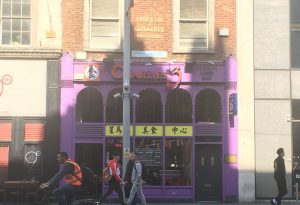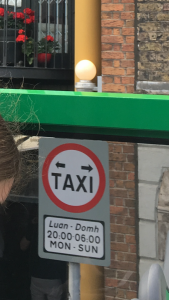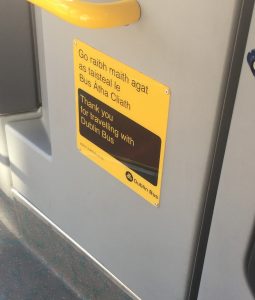While Irish has big visual precedence in Dublin, you won’t hear it spoken aloud very often– except by the bus stop announcement. If you ride DublinBus or the LUAS (an above ground light rapid rail system), the stops are announced in both English and Irish. You won’t see any other languages on signs besides English and Irish generally unless you are walking into a locally owned Polish grocery store or a Chinese restaurant. But even then, the Chinese writing on the signage is accompanied with an English sign. Above the Chinese restaurant, the street sign is in Irish and English.

You will hear a multitude of different languages if you just sit and listen while waiting for a bus stop you can hear hordes of tourists talking to each other in their native tongues: Spanish, Italian, French, German, Chinese, Japanese, Korean. Dublin aside from being a tourist destination also has a large immigrant community. Still 99.5% of the time, the signage is in English and Irish.
From what I’ve gathered talking with my Irish colleagues, Irish is taught as a language in elementary schools the same way Spanish or French is taught in the US, it is required as an enrichment class. There are also some Irish Medium Instruction schools outside of Dublin where classes are taught in Irish and while these are much less common, they are still present. You’re more likely to hear conversational Irish out in the countryside, but I haven’t heard any myself yet– probably due to the fact that I am unable to hide from my accent and way of carrying myself that I am American and that has impacts on how people interact near me and with me. Needless to say, Irish is everywhere on signage in Dublin but discernably nowhere audibly, save for pre-recorded announcements on public transportation.
Irish is hardly seen on business signage unless you’re traveling west out of Dublin, then you’ll see pubs with Irish names and font stylings. In Dublin, you would be scarce to find a business writing their names or menus in Irish. Government buildings or public institutions almost always have Irish and English signage, sometimes English first and then Irish but I have also seen Irish and then English. Formal things such as graves or names of public institutions tend to show up as more predominantly Irish and without English the more rural and historical you get. But in Dublin: Irish and English aren’t seen without each other.
Street signs that have dates and times tend to have Irish first and then English. (Below, pictured a taxi stand sign: Luan – Domh. Mon- Sun)


There is a larger socio-political implication about the clear intentionality of including signage in Irish, in a place where nobody seems to speak it. For Irish Nationalists, having Irish everywhere is a virtue signal to their love of their culture and country and as a way to clearly distinguish that “we are Irish, not British”. Up until about 1800 Irish was the language that the majority of people spoke but in 1900 the British Government prohibited any use or utterance of Irish in schools. Irish being phased out from the audible landscape was a pretty much entirely direct result of British Colonialism that remains true to this day in Dublin. The historical context and political context of Ireland strongly have shaped their linguistic landscape, while the Irish language is still valued as an aspect of Irish culture, the damage done by British Colonialism has pretty much permanently taken it out of the audible landscape. The reclamation of Irish-ness and Irish culture and nationalism can be seen in the very clear and deliberate choice by the Irish government to include Irish in their signage, not entirely for practical reasons but for symbolic reasons.
I love the way you relate the use of languages to the cultural and historical context in Ireland. It is very interesting and inspiring to read your argument on how Irish people think of their history and language. It seems to me that Irish language has more symbolic meaning than practical meaning.